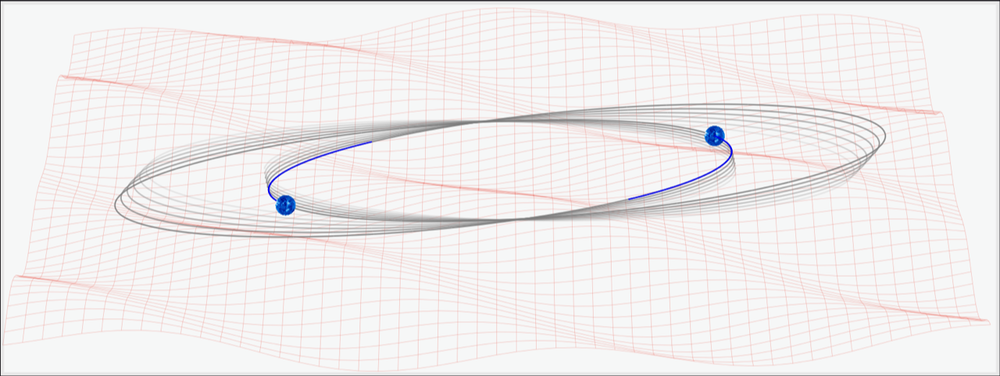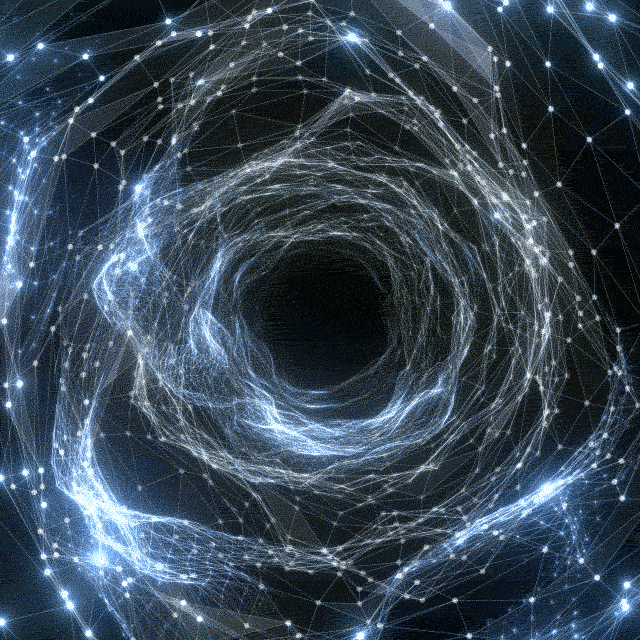
Posted on 03/19/2022 8:40:02 PM PDT by LibWhacker
Thanks to a new analysis technique, precision measurements of the Earth-Moon distance should improve estimates of the size of the gravitational-wave background. NASA Precise measurements of the Earth-Moon distance can allow researchers to estimate the maximum possible amplitude of the steady background “hum” of gravitational waves. (This time-lapse series of photos was taken by a satellite a million miles from Ea... Show more The barrage of all gravitational waves that continuously hit Earth in the microhertz frequency range—roughly one oscillation every few weeks—might be detected by measuring their subtle effects on the Earth-Moon system. By exploiting this decades-old idea, researchers have now shown that the latest laser ranging data could be used to place a significantly smaller upper limit on the possible strength of these waves, compared with previous estimates [1, 2]. The technique promises a powerful new way to probe gravitational waves by using natural orbital systems as sensitive detectors.
Gravitational waves can provide information about some of the most violent events in the Universe, from black hole mergers to the big bang, yet current detectors have a blind spot between two distinct frequency bands. The LIGO-Virgo-KAGRA collaboration—based on laser interferometers located in the US, Europe, and Japan—can detect waves with frequencies in the range from 1 to 1000 Hz. Another detection scheme uses periodic signals from pulsars to detect nanohertz (nHz) gravitational waves, corresponding to one oscillation every few years. So there is a big gap for waves in the microhertz ( μHz) regime, which could be generated, for example, by supermassive black hole binary pairs in the late stages of orbiting each other before merging.
“We’re aiming to fill this gap,” says Alexander Jenkins of University College London. “The idea is to measure how [the waves] influence the orbits of binary systems, including the Earth-Moon system.” Jenkins says that many researchers have helped to develop this idea since the 1970s. In the simplest case, a continuous gravitational wave with the same frequency as the orbital motion could, say, nudge the objects a bit closer together in each cycle. Through this resonance phenomenon, the orbit would change over time in a way that reflects the wave’s properties.

Never a calm moment. If two gravitationally bound objects are continuously buffeted by gravitational waves from throughout the Universe, their mutual orbit will gradually change over time. In 2013, Lam Hui of Columbia University and colleagues showed that gravitational waves in the μHz frequency range could have a potentially measurable effect on binary systems [3]. They demonstrated theoretically that a continuous background from a large number of such waves coming from all directions should cause the period and other orbital parameters to undergo a random walk and thus to change gradually over time. The rate of change would reflect the strength of the prevailing waves.
Using data from a binary pulsar—an orbiting pair of pulsar stars, which emit periodic signals—Hui and colleagues obtained an upper bound on the possible strength of gravitational waves in the μHz gap. Now, Jenkins and Diego Blas of the Autonomous University of Barcelona, Spain, have taken this work further, showing that the accuracy of current data on the Earth-Moon system should allow researchers to derive an upper bound that is much smaller than that derived by Hui and his colleagues.
Jenkins and Blas build on earlier work to develop a mathematical formalism, as well as numerical methods, to follow the random evolution of the orbital motion of any binary system subject to a background of gravitational waves [1]. These mathematical techniques allowed them to make a more precise link between orbital changes and the nature of the gravitational waves driving them. “Our formalism gives a much more complete and rigorous way to calculate all of the effects that a gravitational-wave background would have on a given binary system,” Jenkins says.
In a companion paper, the researchers use these methods to propose a pathway to lowering the bound on the strength of the gravitational-wave background in the current “blind spot” [2]. This can be done, they argue, by using laser ranging measurements of the Moon to determine precise changes in the Earth-Moon orbit and then comparing these with the predictions of the theory. The results, according to their estimates, should improve researchers’ knowledge of the possible amplitude of these waves by more than 100 times.
“This is an exciting and novel way of seeing gravitational waves,” says black hole physicist Vitor Cardoso of the Instituto Superior Técnico, Lisbon, Portugal. “The idea is simple, but it requires difficult calculations to implement and show that it works.” Moreover, this alternative approach to detection could reveal unexpected gravitational-wave sources, he says. We may find “that the Universe is full of mysterious gravitational-wave content.”
Regarding next steps, Jenkins believes that more theoretical work is needed. For example, “it's not just individual binary systems—we also need to see how entire galaxies respond to gravitational waves,” he says.
In theory this is cool.
I am confused about any practical applications
Hold on there, Hoss. First the theory, then the Tang! ;-)

Gravitational waves apparently have some influence on atmospheric phenomena here on earth. See https://apod.nasa.gov/apod/ap220313.html?fbclid=IwAR3ZqAdcj6pd3ccCDWv59L4PPXyrd4dq7IW5I8hcpCPsvhDHMlQi6SGeNrs
Hence, observation of changes in gravity wave rates might aid in making more accurate weather predictions.
In 1969, during the first Moon landing, one of the first instruments deployed was a permanent laser device pointed at Earth.
From memory, it improved measurements of the distance between Earth and Moon down to plus or minus 12 inches.
Is it possible that device is still working after more than 50 years?
It’s a reflector, so it should theoretically last as long as the moon itself.
Reflector - thanks for the correction.
Dust and meteorites might have shortened its useful life.
There are five, three US and two Russian. All operational, according to wikipedia.
Pictures at article
https://en.wikipedia.org/wiki/List_of_retroreflectors_on_the_Moon
Thanks for the Laser Ranging link.
Current accuracy 1.1 mm.
Amazing.
There was some scientific study using those lasers, showing that the moon was vibrating back & forth as if it had been knocked off its trajectory. Someone did the math and it went back to some date maybe 600 years ago. They found a reference to some monks who looked at the moon one night and saw a massive explosion. That was against dogma because the heavens were supposed to be immutable or somesuch sumthin sumthin. Sure enough, there’s a 600 year old crater on the moon corresponding to when a very large asteroid hit it.
https://www.quora.com/When-was-the-last-time-the-moon-was-severely-hit-by-a-meteor
Probably 1178.
In that year, Gervase, chronicler of the Christ Church monastery in Canterbury, England, recorded the following:
This year on the Sunday before the Feast of Saint John the Baptist, after sunset when the moon was first seen, a marvellous sign was seen by five or more men sitting facing it. Now, there was a clear new moon, as was usual at that phase, its horns extended to the east; and behold suddenly the upper horn was divided in two. Out of the middle of its division a burning torch sprang, throwing out a long way, flames, coals and sparks. As well, the moon’s body which was lower, twisted as though anxious, and in the words of those who told me and had seen it with their own eyes, the moon palpitated like a pummelled snake. After this it returned to its proper state.
Some researchers believe they had witnessed the impact that formed the Giordano Bruno crater, which is approximately the correct age:
I understand the Moon is moving away from the Earth at about a foot a year.
Somebody ought to lasso it before it gets away.
It’s a retroreflector, A passive device. So long as we have a laser powerful enough to reach the Moon and a telescope to detect the dot, it will work.
By the way in reference to the so called 600 year old crater, the high-resolution images from the Terrain Camera on SELENE (Kaguya) show numerous small craters superposed on the ejecta blanket of Giordano Bruno. The size-frequency distribution of these small craters led Morota and colleagues to establish an age of 4 million years for Giordano Bruno
Thanks Nateman. Regarding the GB crater, an estimate from size-frequency distribution estimates based on the bias of no large lunar impacts isn't a refutation, afaic.
- 11780618 [keyword]
Disclaimer: Opinions posted on Free Republic are those of the individual posters and do not necessarily represent the opinion of Free Republic or its management. All materials posted herein are protected by copyright law and the exemption for fair use of copyrighted works.